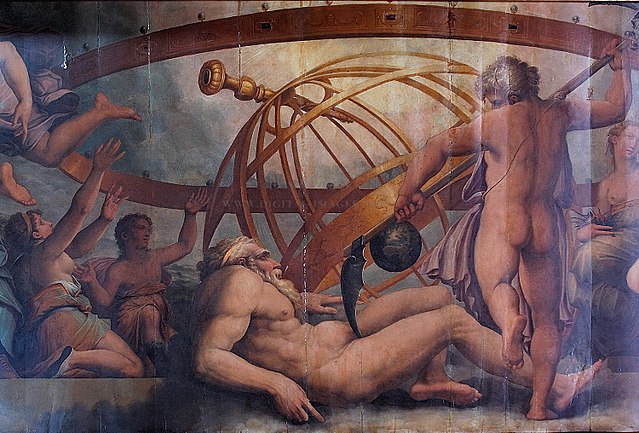Note: The Urania section is edited and fleshed-out from last year’s A to Z post. It was really hard to find anyone from Greek mythology whose name starts with a U (either in the original Greek or Latinized forms), so it was a rather foregone conclusion.

The Muses Urania and Calliope, by Simon Vouet, ca. 1634
Urania (Ourania) is one of the nine Muses, conceived and born when Zeus and Mnemosyne slept together on nine consecutive nights. Some sources name her as the oldest of the Muses. From her mother, she inherited grace and beauty, and from her father, she inherited majesty and power.
She’s the Muse of astronomy, and foretells the future through the stars. Urania most loves those who love philosophy and the heavens. Those who’ve been taught by her are raised into the heavens, since the power of thoughts and imagination lift the human soul to heavenly heights.

Urania, by Giuseppe Fagnani, 1869
Urania wears a cloak embroidered with stars, and a crown of stars. She’s also usually depicted with a celestial globe, to which she points with a staff. Urania keeps her eyes focused on the stars, her realm.
Some sources name her as the mother of musician Linus (by Apollo), and the god Hymenaeus (by Dionysus). Hymenaeus is the winged god of marriage ceremonies, song, and inspiring feasts. He was supposed to attend every wedding, for if he didn’t, the marriage would be a disaster.
In the Renaissance, she became a popular Muse for poets.
Urania is derived from ouranios, “heavenly.”

Uranus (Ouranos) is one of the fifteen primordial deities. He represents the sky, and was asexually conceived by his mother Gaia. Other sources cite his father as Aether, the personification of upper air; still other sources name his parents as Aether and Hemera (personification of day), or cite his mother as Nyx (personification of night).
Since the Greek deities were one big dysfunctional family, Uranus later married Gaia and had many children with her—the Titans, the Giants, the Cyclopses, the Furies, the Meliae (ash tree nymphs), and the Hecatoncheires (Hundred-Handed Ones).
Every night, Uranus coupled with Gaia, but he hated all his kids, and began hiding them deep in Tartarus, causing great pain to Gaia. Since she personified the Earth, these kids were in her physical body and unable to get out. Hoping to end this situation, Gaia made an adamantine sickle and told Kronos to lie in wait to ambush Uranus.

Detail of The Mutiliation of Uranus by Saturn, by Giorgio Vasari
Kronos leapt out and castrated Uranus next time he came to couple with Gaia. Aphrodite was born from the severed genitals falling into the sea, and the blood drops falling to the ground created the Giants, the Meliae, and the Furies. Some sources say the blood also birthed the Telchines, the original inhabitants of Rhodes.
After Uranus’s overthrow, Kronos re-imprisoned the Hecatoncheires and Cyclopses in Tartarus. Gaia and Uranus told him he’d be overthrown by his own children, so Kronos swallowed each at birth to prevent this. Only Zeus avoided this fate, due to his mother Rhea and grandmother Gaia’s clever thinking.
On 13 March 1781, the seventh planet was discovered and named after Uranus.
Uranus, like Urania, is derived from ouranios, “heavenly.”


Pingback: A to Z Reflections 2017 « Onomastics Outside the Box
Thanks Carrie Anne for this wonderful blog on the story of Uranus and Urania. I was writing a blog too on the upcoming Uranian transit through Taurus and found this very useful. In fact, I have linked this page to my blog as well and I hope you don’t mind. Here is the link to my blog:
https://swasays.blogspot.in/2018/04/uranus-in-aries-moving-into-taurus-in.html